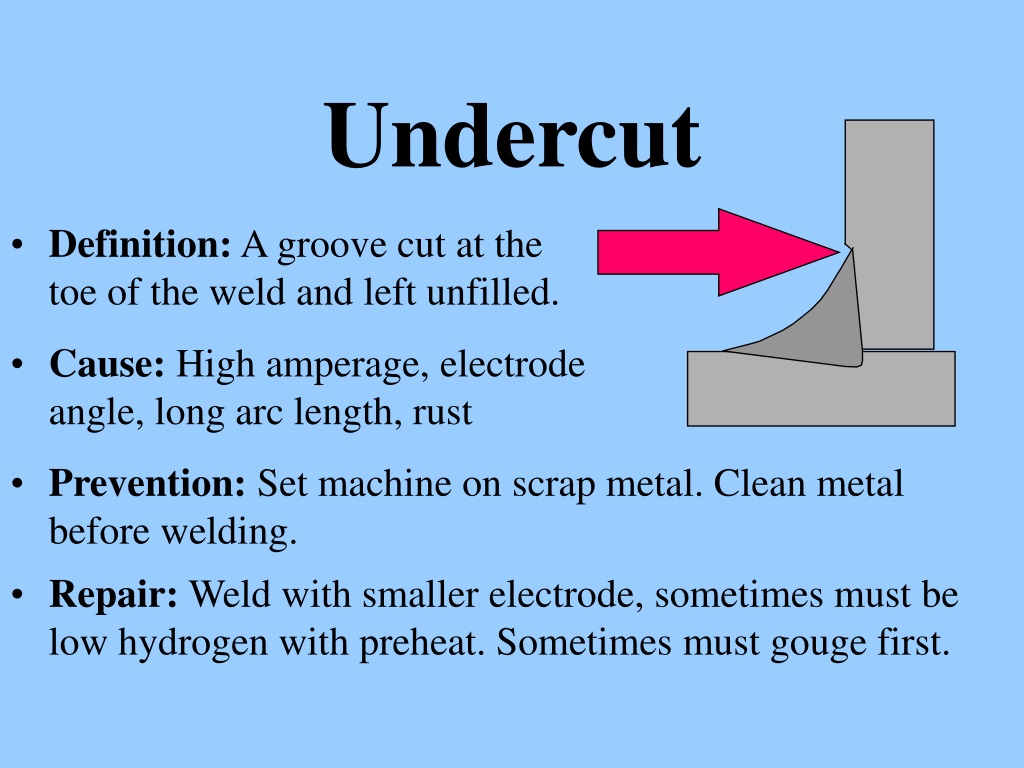Mastering the Art of Welding: How to Prevent Undercut Welding Issues for Flawless Manufacture Outcomes
By recognizing the root creates of undercut welding and carrying out effective techniques to stop it, welders can boost their craft to brand-new levels of excellence. In the quest of remarkable fabrication outcomes, mastering the art of welding to stay clear of undercut concerns is not simply an ability however a need for those aiming for perfection in their work.
Understanding Undercut Welding

To avoid undercut welding, welders should make certain correct welding specifications, such as readjusting the current, voltage, traveling rate, and keeping the proper electrode angle. Additionally, using the proper welding method for the details joint setup is vital. Utilizing weaving motions or backstepping methods can aid guarantee appropriate weld steel deposition and decrease the possibility of undercut formation. Routine examination of welds throughout and after the welding process is likewise vital to capture any kind of undercut very early and make essential adjustments to stop further issues. Preventing weld undercut. By understanding the sources of undercut welding and executing precautionary procedures, welders can achieve premium, structurally audio welds.
Reasons For Undercut in Welding
Recognizing the variables that add to undercut in welding is vital for welders to generate top quality, structurally sound welds. When the weld steel does not properly fill the groove developed between the base steel and the formerly transferred weld metal, undercutting takes place. A number of aspects can cause undercut in welding. One usual cause is too much heat input. Welding at high temperatures for extensive periods can cause the base metal melting greater than preferred, leading to damage. Insufficient welding incorrect or current welding rate can also contribute to damage. Insufficient current might not give adequate warmth to thaw the base and filler steels effectively, while too much rate can protect against correct combination, causing undercut. In addition, improper electrode angles or wrong lantern manipulation techniques can develop locations of reduced weld steel check deposition, advertising undercut. Comprehending these reasons and executing proper welding strategies can aid avoid undercutting concerns, guaranteeing solid and long lasting welds.
Strategies to stop Undercutting

To alleviate the threat of undercutting in welding, welders can use tactical welding methods aimed at enhancing the top quality and honesty of the weld joints. Additionally, using the proper welding strategy for the specific joint arrangement, such as weave or stringer beads, can add to reducing undercutting.
Using back-step welding techniques and managing the weld bead profile can also aid distribute warmth uniformly and decrease the threat of undercut. Normal evaluation of the weld joint during and after welding, as well as carrying out high quality assurance steps, can aid in attending to and spotting undercutting issues without delay.
Importance of Proper Welding Parameters
Choosing and preserving appropriate welding criteria is vital for accomplishing successful welds with marginal flaws. Welding criteria describe variables such as voltage, current, take a trip speed, electrode angle, and securing gas circulation rate that directly impact the welding process. These criteria have to be thoroughly why not look here changed based upon the sort of product being bonded, its thickness, and the welding technique used.
Proper welding specifications ensure the correct amount of warm is related to melt the base steels and filler material evenly. If the parameters are set as well high, it can cause excessive warmth input, triggering burn-through, spatter, or distortion. On the other hand, if the criteria are also low, insufficient combination, lack of infiltration, or undercutting may occur.
Quality Control in Welding Operations

Final Thought
To conclude, grasping the art of welding calls for a detailed understanding of undercut welding, its reasons, and methods to avoid it. By making sure proper welding specifications and carrying out quality control techniques, remarkable construction results can be achieved. It is important for welders to consistently pursue quality in their welding operations to prevent undercut problems and generate top notch welds.
Undercut welding, a common flaw in welding processes, happens when the weld metal doesn't effectively fill up the groove and leaves a groove or anxiety along the welded joint.To prevent undercut welding, welders must ensure correct welding criteria, such as changing the existing, voltage, traveling rate, and maintaining the proper electrode angle. Poor welding inaccurate or current welding speed can also add to damage.To reduce the danger of undercutting in welding, welders can utilize tactical welding techniques aimed at enhancing the quality and honesty of the weld joints.In conclusion, mastering the art of welding calls for a comprehensive understanding of anonymous undercut welding, its reasons, and methods to prevent it.